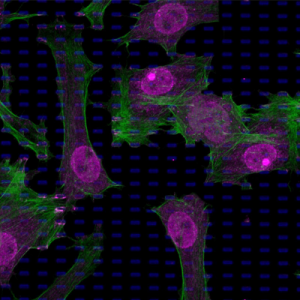Cellular manipulation could advance biomedical research, robotic actuation and even the cleaning of industrial surfaces

Cells in developing tissues respond to local mechanical forces by adjusting their growth, differentiation and migration patterns. Being able to mimic these changes accurately outside the body could lead to a better understanding of the underlying molecular mechanisms and create new opportunities for tissue engineering and drug development. Current cell manipulation methods, however, either investigate the behavior of single cells taken out of their natural tissue context, or they deform entire cell sheets without control over individual cells.
A study in Nature Communications presents a new approach that bridges this gap in cell manipulation. The team from the Harvard A. Paulson School of Engineering and Applied Sciences (SEAS), the Wyss Institute for Biologically Inspired Engineering at Harvard University and the Department of Chemistry and Chemical Biology at Harvard's Faculty of Arts and Sciences (FAS), has developed a hybrid material that can enable highly controllable cell deformations on dimensions ranging from an entire cell sheet down to small areas of individual cells.
"With its unique abilities, relative ease of synthesis and use, our new materials approach overcomes existing experimental limitations, and could advance the investigation of force-related aspects of cell morphogenesis, cell movements and cell-cell interactions in a highly controllable and more life-like in vitro format," said Joanna Aizenberg, the Amy Smith Berylson Professor of Materials Science at SEAS and Wyss Institute Core Faculty member.
The method can be applied to single cells, microorganisms or larger networks of cells like those that form tissues. It enables new investigational tools for different research areas, including cell and developmental biology, regenerative medicine and drug testing.

This broad spectrum of possible applications is rooted in the material's design and activation. The material consists of arrays of tiny microplates embedded in a hydrogel. Cells grown on the top surface of this hybrid material tightly adhere to the tips of microplates. The hydrogel can be locally heated up with focal laser light and made to contract like a muscle, pulling neighboring microplates apart and stretching cells on the surface. This process is quickly reversible and safe for cells as they are not heated together with the hydrogel.
"By varying the patterns and dimensions of the microstructure skeleton in the hydrogel, we are able to generate optimal substrates for different cell sources, and by varying the positioning and distribution of the laser light, we can manipulate either single cells and subcellular areas within a complex cell sheet, or larger segments of the sheet," said Tanya Shirman, a Technology Development Fellow at the Wyss Institute and co- author of the paper. "The applied forces and response times mirror those in real tissues and are thus highly physiological."
This versatile material platform could also be used in research not related to cell studies or tissue engineering, such as stimuli-responsive materials, actuators, robotics, active antifouling surfaces, and adaptive optics. For example, the movements of robots and deformation of synthetic joints could be controlled with light directed at critical areas, or industrial surfaces could be cleared from contaminating organisms by shining the light at the fouled region, inducing local actuation of the surface and releasing the contaminants.
More information: Amy Sutton et al. Photothermally triggered actuation of hybrid materials as a new platform for in vitro cell manipulation, Nature Communications (2017). DOI: 10.1038/ncomms14700
Journal information: Nature Communications
Provided by Harvard University



















